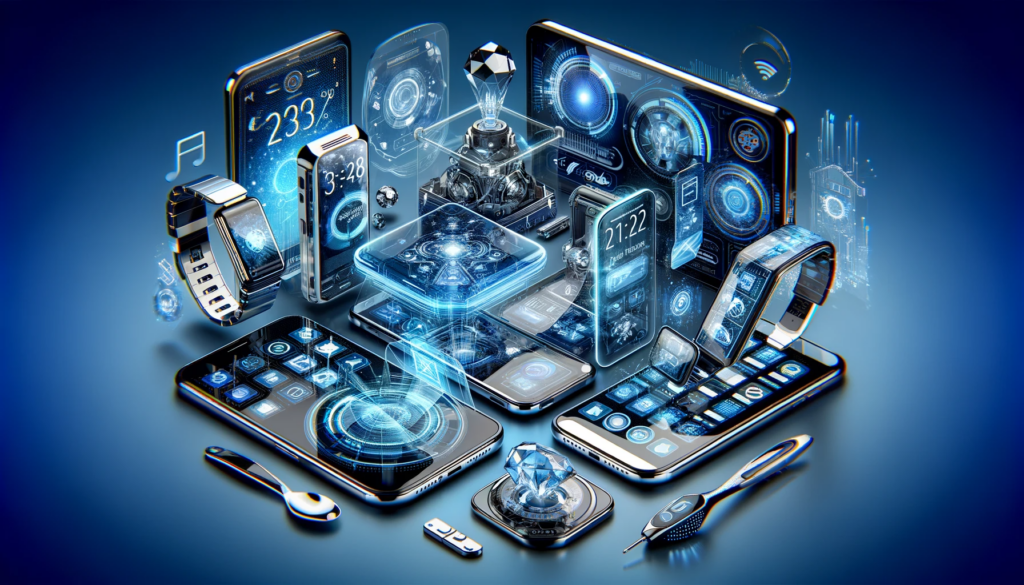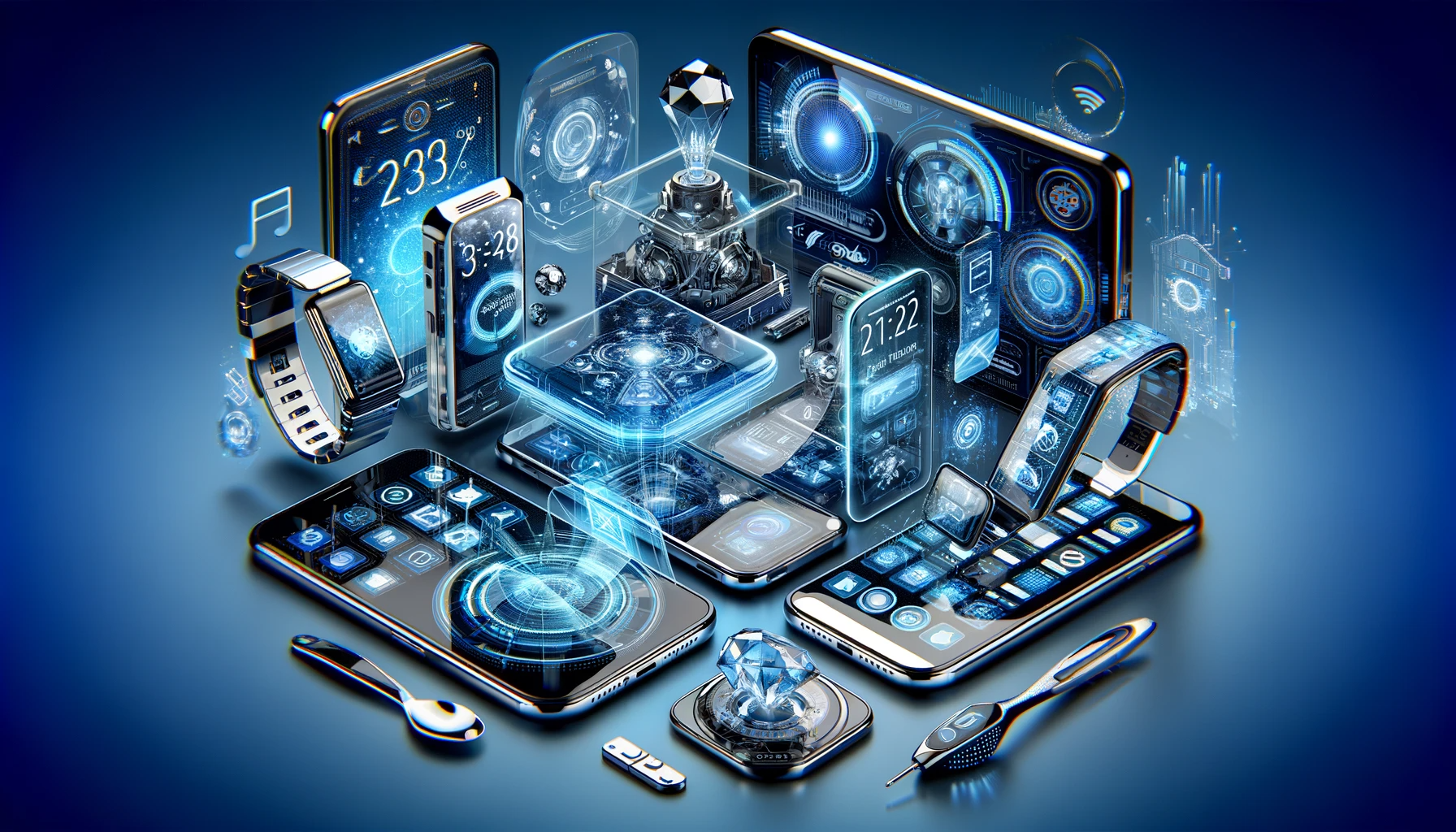Exploring Upcoming Trends in Smartphone Technology
As we advance further into the digital age, it’s clear that mobile devices and smartphones are set to play an even more central role in our daily lives. Our dependence on these devices has grown exponentially over the past decade, prompting tech companies to continually innovate and integrate cutting-edge features into their latest models. The future of mobile device technology is bright and filled with exciting possibilities. A key trend to keep an eye on is the integration of artificial intelligence (AI) into mobile devices. AI has already made its way into our phones through voice-activated assistants like Siri and Alexa. However, future innovations will see AI become far more sophisticated, enabling users to seamlessly interact with their surroundings via their smartphones. We’ll see features like predictive typing becoming more accurate, image recognition improving significantly, and personal assistants that can predict our needs before we even know them ourselves. Another area where significant advancements are expected is in the realm of Augmented Reality (AR) and Virtual Reality (VR). Mobile manufacturers are increasingly focusing on integrating AR/VR capabilities into their devices, making immersive experiences accessible right from your pocket. Imagine being able to project a meeting or a movie onto any surface or get lost in a virtual world while sitting on your couch at home. As fascinating as these developments may seem, they merely represent the tip of the iceberg when it comes to what lies ahead for smartphone technology.

Predictions for the Evolution of Tablets
Tablets, since their inception, have been a bridge between smartphones and laptops, offering the convenience of the former and the functionality of the latter. It’s predicted that tablets will continue to evolve in ways that further refine this balance. One significant development we can anticipate is the enhancement of detachable or foldable displays. With tech giants like Samsung already leading the way with foldable phones, it’s not far-fetched to suggest that tablets will follow suit. This adaptability could transform tablets from static devices into more dynamic tools capable of serving multiple purposes. In addition to physical alterations, advancements in software are also anticipated to significantly reshape the tablet experience. The introduction of advanced AI systems within these devices can bring about a revolution in user interaction. For example, rather than utilizing traditional methods such as typing or swiping, users might simply need to voice their commands or even use gestures. Machine learning algorithms could also personalize and enhance user experiences based on individual preferences and behavioral patterns. Moreover, there’s an expectation for an increase in specialization within tablet technology. While general-purpose tablets won’t disappear entirely, we’ll likely see more models designed for specific industries or tasks – from graphic design and video editing to medical applications or educational tools. These specialized tablets would come equipped with tailored features such as high-end display panels for designers or robust data management systems for healthcare professionals. As we move forward into this exciting future, it seems clear that tablets will remain essential tools for productivity and entertainment alike, adapting continuously to meet our ever-changing needs and desires.
The Shift Towards Flexible Screens: What to Expect
The concept of flexible screens is not entirely new, but it is only recently that we’ve begun to see its potential fully realized. To date, the most notable examples have been in smartphones like Samsung’s Galaxy Fold and Motorola’s Razr. These devices make use of flexible display technology to provide a larger screen when needed while maintaining a compact form factor. The shift towards such screens could herald a significant change in how we interact with our mobile devices. Moving forward, we can anticipate an even greater integration of flexible displays into various types of mobile technology. Tablets, as mentioned earlier, are prime candidates for this development. But it’s not just about folding or bending screens; other exciting possibilities include rollable or even stretchable displays. LG has already showcased a rollable TV – a hint at what might be possible for mobile devices in the future. This increased flexibility will not only offer more adaptability in terms of physical design but should also facilitate more immersive experiences by allowing larger, high-resolution displays within smaller, portable devices. The move towards flexible screens isn’t without challenges though. For instance, ensuring durability and longevity while maintaining flexibility will be a key concern for manufacturers. Moreover, creating user interfaces that effectively leverage these dynamic displays is another hurdle to overcome. Regardless, given the immense potential benefits and the relentless pace of technological advancement, it seems inevitable that flexible screens will play an increasingly prominent role in the future landscape of mobile devices. Do expect to see more innovations and improvements as this technology continues to evolve and mature over time.
The Rise of Augmented Reality (AR) and Virtual Reality (VR) Capabilities
Augmented Reality (AR) and Virtual Reality (VR) are two technology trends that are set to revolutionize the landscape of mobile devices. AR overlays digital information onto the real world, enhancing our perception and interaction with our surroundings. On the other hand, VR immerses us completely in a virtual environment, offering a fully interactive experience isolated from the physical world. These technologies are not merely limited to gaming; they have far-reaching implications across multiple sectors such as education, healthcare, retail, and more. The integration of AR and VR capabilities into mobile devices has been gaining traction in recent years. Tech giants like Apple and Google have been making significant strides in this space through platforms like ARKit and ARCore respectively. These platforms enable developers to create AR-enabled applications for smartphones. Similarly, standalone VR headsets like Oculus Quest 2 offer untethered VR experiences without the need for a high-end PC or cables. However, there’s still much room for growth and improvement. One can expect to see more advanced sensors for better tracking, improved display resolutions for clearer visuals, longer battery life for extended usage times, and miniaturization of components to make devices lighter and more comfortable to use. While we’re yet to see these technologies reach their full potential in mobile devices, it’s clear that they represent a significant future trend. The immersive experiences offered by AR & VR hold vast possibilities – imagine conducting virtual meetings with holographic avatars of colleagues from around the world or exploring digitized versions of historical sites right from your living room! As these technologies continue to evolve and improve over time, they will undoubtedly redefine how we interact with digital content on our mobile devices. So keep an eye out for exciting advancements in this space!
5G and Beyond: The Future of Connectivity
As we move forward into the future of mobile technology, another area that promises to accelerate our digital experiences is connectivity. 5G, or the Fifth Generation of wireless communications technologies supporting cellular data networks, has been a buzzword in the tech industry for quite some time now. With promises of faster speeds, lower latency, and greater capacity, 5G is set to transform the way we use our mobile devices. The advent of 5G means that data-intensive applications such as streaming high-definition videos or playing online games will be smoother and more efficient than ever before. However, the potential of 5G extends far beyond just enhanced mobile broadband. The advanced capabilities of this technology can enable a whole new array of applications – from powering connected cars and smart cities to facilitating remote surgery in healthcare. Furthermore, with its increased network capacity and ability to connect a massive number of devices simultaneously, 5G can play a pivotal role in propelling Internet-of-Things (IoT) implementations on a large scale. While it’s important to acknowledge the transformative potential that 5G holds, it’s equally crucial to understand that this is just one step in our ongoing journey towards better connectivity. As we race towards an increasingly connected world, research into next-generation networks like 6G has already begun. Though still in its nascent stages, these future technologies promise even higher speeds and more seamless interconnectivity between devices. So as we continue exploring what’s next for mobile technology, it’s certain that better and faster connectivity will remain at the heart of all innovations.
Artificial Intelligence Integration in Portable Gadgets
Artificial Intelligence (AI) has been making waves in various sectors of technology for quite some time now, and mobile devices are no exception. When we look at the current trends, it’s clear that AI integration in portable gadgets is not only becoming more prevalent but also more sophisticated. This technology goes beyond just applying filters on your photos or predicting your next word while typing a message. Today, AI powers virtual assistants on our phones, recommends what to watch next based on our viewing habits, and even helps manage battery usage for optimal performance. The next step in this journey involves moving from reactive AI functionalities to predictive ones. The future could see our devices understanding our daily patterns and preferences so intricately that they can anticipate our needs before we even express them. Imagine your phone suggesting you take an umbrella because it predicts rain later in the day or reminding you to call a family member because it’s their birthday. These intuitive interactions not only make our experiences with mobile devices smoother but also more personalized. While we’re still exploring the full potential of AI in portable gadgets, one thing is certain – its role will become increasingly central as we progress further into the digital age. From aiding accessibility features to powering augmented reality experiences, AI’s capabilities seem limitless. As these technologies continue to evolve and mature, we stand on the brink of a future where our mobile devices are more than just communication tools – they are smart companions that adapt and learn from us every step of the way.
Wearable Tech: A Glimpse into Tomorrow’s Fashion
Wearable technology is another domain that’s set to revolutionize the future of mobile devices. These aren’t just limited to fitness trackers or smartwatches anymore. The wearable tech of tomorrow encompasses a broad spectrum – from contact lenses that can monitor diabetic blood sugar levels to smart rings for contactless payments and even clothing with embedded sensors for body temperature regulation. Such innovations are blurring the lines between fashion and functionality, making technology an integral part of our daily outfits. As we delve deeper into this trend, it’s interesting to note how wearable tech has the potential to disrupt traditional industries and create new experiences. For instance, the healthcare sector could greatly benefit from these advancements, with wearables facilitating continuous health monitoring and alerting users about potential issues promptly. Likewise, in the entertainment industry, wearables could enable more immersive experiences by offering augmented reality or haptic feedback features. Looking ahead, we can anticipate a world where wearable technology is seamlessly woven into our everyday lives – enhancing convenience, empowering us with real-time data and providing unparalleled connectivity. Not only will they serve practical purposes but also embody personal style statements. This exciting fusion of fashion and technology promises a future where our wardrobes are as smart as our phones!
Advanced Security Features Set to Influence the Market
As we continue to explore the future of mobile devices, a crucial factor that can’t be overlooked is advanced security features. With an increasing reliance on digital platforms for activities like banking, shopping, and communication, safeguarding sensitive data has become paramount. The next wave of mobile device innovation is set to prioritize user safety with heightened security features. One such promising development in this realm is biometric authentication. This technology uses unique biological characteristics like fingerprints, facial recognition, or iris scans to verify user identities. Biometric authentication not only augments security but also enhances user convenience by enabling quick access without the need for passwords or PINs. However, it’s essential to note that while these advancements offer improved protection against cyber threats, they also raise critical questions about privacy and data misuse that need addressing. Another noteworthy trend set to influence the market is blockchain technology. By offering decentralized and tamper-proof systems for transactions, blockchain can significantly bolster the security of mobile devices. In addition to financial transactions, blockchain’s potential use cases extend into securing personal data storage and even verifying software updates for devices. Therefore, as we navigate towards a more digitally intertwined future, it becomes evident that advanced security features will play a pivotal role in shaping the trajectory of mobile device evolution – promoting safer environments while facilitating seamless digital experiences.
Environmental Impact: The Push for Sustainable Electronics
As we delve deeper into the future of mobile devices, it’s impossible to ignore the rising concerns surrounding the environmental impact of electronic devices. In recent years, these concerns have initiated a push for more sustainable electronics – a trend that is set to significantly influence the mobile device industry. One development that highlights this shift towards sustainability is the increasing emphasis on device durability and lifespan. Consumers are now seeking devices that not only offer advanced features but also promise longevity, reducing electronic waste in the process. This demand has prompted manufacturers to focus more on creating sturdy designs and offering better post-purchase support with regular software updates and efficient repair services. Simultaneously, there’s an increased awareness about the need for recycling old devices efficiently. Many companies have already introduced take-back programs where consumers can return their used electronics for safe disposal or refurbishment. Moreover, there’s a growing interest in creating devices from recycled or bio-based materials, further minimizing the ecological footprint of mobile technology. While these efforts mark important steps forward, they also emphasize that much work remains as we strive towards making mobile technology truly sustainable.
Final Thoughts on the Unfolding Future of Technological Advancements
As we look ahead, the future of mobile devices is brimming with possibilities. The industry continues to evolve at a rapid pace, spurred on by technological advancements and changing consumer preferences. Emerging trends such as foldable screens, 5G connectivity, AI integration and augmented reality applications are poised to redefine our understanding of what a mobile device can do. This continuous innovation promises an exciting future but also poses new challenges that will require novel solutions. In particular, the advent of 5G technology is set to revolutionize the way we use our mobile devices. With its superior speed and lower latency, 5G will enable real-time interactions on a whole new level. Not only will it enhance existing services like video streaming and gaming, but it could also potentially open up new avenues in fields like telemedicine and remote learning. At the same time, implementing this new network technology effectively will demand significant infrastructural changes and improvements in device capabilities. Moreover, artificial intelligence (AI) continues to become more deeply integrated into our mobile devices. We’re already seeing AI-powered voice assistants becoming commonplace and predictive text algorithms getting more accurate with each update. Looking forward, we may see even more sophisticated AI features such as real-time language translation or advanced health monitoring systems integrated into our smartphones. Despite these advances though, there’s still much room for progress before we fully unlock the potential of AI in mobile technology.

